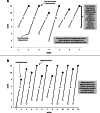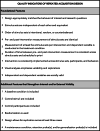How to Be RAD: Repeated Acquisition Design Features that Enhance Internal and External Validity
- PMID: 34632283
- PMCID: PMC8476682
- DOI: 10.1007/s40614-021-00301-2
How to Be RAD: Repeated Acquisition Design Features that Enhance Internal and External Validity
Erratum in
-
Correction to: How to Be RAD: Repeated Acquisition Design Features that Enhance Internal and External Validity.Perspect Behav Sci. 2021 Oct 19;44(4):705. doi: 10.1007/s40614-021-00320-z. eCollection 2021 Dec. Perspect Behav Sci. 2021. PMID: 35098032 Free PMC article.
Abstract
The Repeated Acquisition Design (RAD) is a type of single-case research design (SCRD) that involves repeated and rapid measurement of irreversible discrete skills or behaviors through pre-and postintervention probes across different sets of stimuli. Researchers interested in the study of learning in animals and humans have used the RAD because of its sensitivity to detect immediate changes in rate or accuracy. Despite its strengths, critics of the RAD have cautioned against its use due to reasonable threats to internal validity like pretest effects, history, and maturation. Furthermore, many methodologists and researchers have neglected the RAD in their SCRD standards (e.g., What Works Clearinghouse [WWC], 2020; Horner et al., 2005). Unless given guidance to address threats to internal validity, researchers may avoid the design altogether or continue to use a weak version of the RAD. Therefore, we propose a set of 15 quality RAD indicators, comprising foundational elements that should be present in all RAD studies and additional features that enhance causal inference and external validity. We review contemporary RAD use and describe how the additional features strengthen the rigor of RAD studies. We end the article with suggested guidelines for interpreting effects and the strength of the evidence generated by RAD studies. We invite researchers to use these initial guidelines as a jumping off point for a more RAD future.
Keywords: behavior analysis; education; measurement; repeated acquisition design; single-case research design.
© Association for Behavior Analysis International 2021.
Conflict of interest statement
Conflict of InterestThe authors report no conflicts of interest.
Figures




Similar articles
-
Correction to: How to Be RAD: Repeated Acquisition Design Features that Enhance Internal and External Validity.Perspect Behav Sci. 2021 Oct 19;44(4):705. doi: 10.1007/s40614-021-00320-z. eCollection 2021 Dec. Perspect Behav Sci. 2021. PMID: 35098032 Free PMC article.
-
Applying the Taxonomy of Validity Threats from Mainstream Research Design to Single-Case Experiments in Applied Behavior Analysis.Behav Anal Pract. 2018 Sep 20;11(3):228-240. doi: 10.1007/s40617-018-00294-6. eCollection 2018 Sep 28. Behav Anal Pract. 2018. PMID: 30363794 Free PMC article.
-
Concurrence on Nonconcurrence in Multiple-Baseline Designs: A Commentary on Slocum et al. (2022).Perspect Behav Sci. 2022 Jun 3;45(3):661-666. doi: 10.1007/s40614-022-00342-1. eCollection 2022 Sep. Perspect Behav Sci. 2022. PMID: 36249166 Free PMC article.
-
Computing tools for implementing standards for single-case designs.Behav Modif. 2015 Nov;39(6):835-69. doi: 10.1177/0145445515603706. Epub 2015 Sep 9. Behav Modif. 2015. PMID: 26358925 Review.
-
A Primer on Single-Case Research Designs: Contemporary Use and Analysis.Am J Intellect Dev Disabil. 2019 Jan;124(1):35-56. doi: 10.1352/1944-7558-124.1.35. Am J Intellect Dev Disabil. 2019. PMID: 30715924 Review.
Cited by
-
Caregiver-Implemented AAC Interventions for Children with Intellectual or Developmental Disabilities: a Systematic Review.Rev J Autism Dev Disord. 2025 Jun;12(2):290-310. doi: 10.1007/s40489-023-00394-2. Epub 2023 Jul 28. Rev J Autism Dev Disord. 2025. PMID: 40893926 Free PMC article.
-
The role of single case experimental designs in evidence creation in rehabilitation.Eur J Phys Rehabil Med. 2024 Dec;60(6):1100-1111. doi: 10.23736/S1973-9087.24.08713-6. Epub 2024 Oct 7. Eur J Phys Rehabil Med. 2024. PMID: 39374052 Free PMC article.
-
Examination of a Modified Incremental Rehearsal Approach to Explore Causal Mechanisms.J Behav Educ. 2022 Jul 28:1-24. doi: 10.1007/s10864-022-09482-5. Online ahead of print. J Behav Educ. 2022. PMID: 35919840 Free PMC article.
References
-
- Boren JJ. The repeated acquisition of new behavioral chains. American Psychologist. 1963;18(7):421–421.
-
- Bouck, E. C., Flanagan, S., Joshi, G. S., Sheikh, W., & Schleppenback, D. (2011). Speaking math: A voice input, speech output calculator for students with visual impairments. Journal of Special Education Technology, 26(4), 1–14. 10.1177/016264341102600401.
-
- Brown, C. H., Wyman, P. A., Guo, J., & Peña, J. (2006). Dynamic wait-listed designs for randomized trials: New designs for prevention of youth suicide. Clinical Trials, 3(3), 259–271. 10.1191/1740774506cn152oa. - PubMed
-
- Butler, C., Brown, J. A., & Woods, J. J. (2014). Teaching at-risk toddlers new vocabulary using interactive digital storybooks. Contemporary Issues in Communication Science & Disorders, 41, 155–168. https://doi.org/1092-5171/14/4102-0155.
LinkOut - more resources
Full Text Sources
